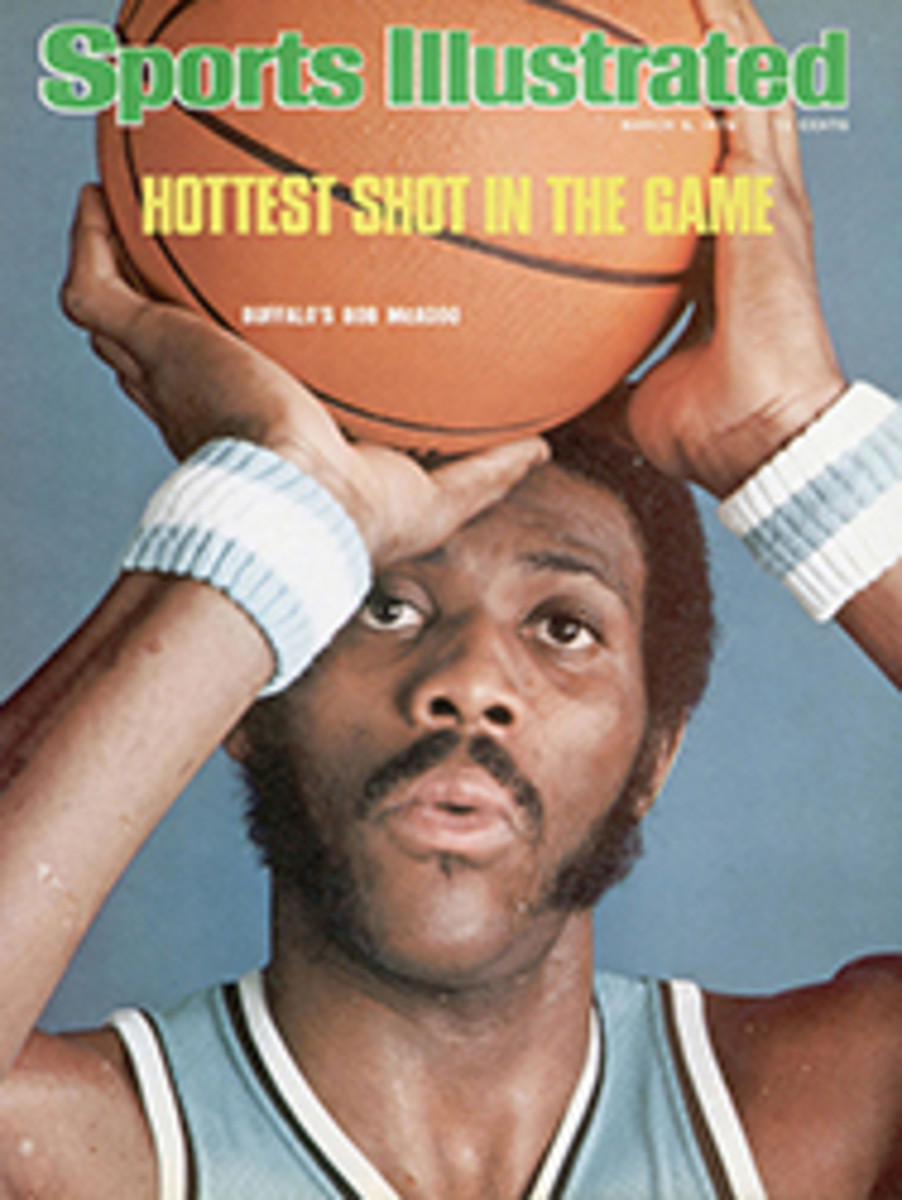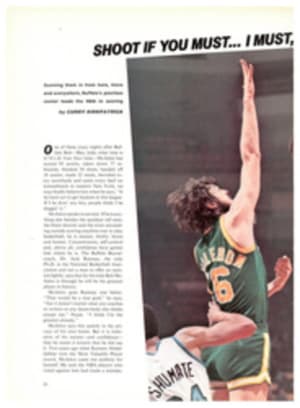
Quick thrust to the fore
Douglas Fairbanks aside, we are not a nation of fencers. The best we have done since the U.S. first entered an official team in the 1912 Olympics is one silver and five bronze, the last, a bronze, going to Albert Axelrod in the foil at Rome in 1960.
But this July in Montreal, Peter Westbrook may change all this. Black and only 23 in a sport traditionally dominated by white Europeans in their 30s, Westbrook has improved so dramatically in so short a period that he has a chance, albeit slim, to win a gold medal in the saber. According to Csaba Elthes, U.S. Olympic coach since 1964, Westbrook is the most promising fencer ever developed in this country.
Westbrook started fencing at 15 when he was a sophomore at Essex (N.J.) Catholic High (the alma mater of runner Marty Liquori and Mark Murro, the U.S. record holder in the javelin). New Jersey, perhaps the only scholastic fencing hotbed in the U.S., permits the use of all weapons—épée, foil and saber—in high school competition. By the time Westbrook was 19 he had not only won the interscholastic state championship, but had also had four years experience with his favorite weapon, saber. This leapfrogged him ahead of his competition at NYU, a perennial fencing power, and in 1973 he handily won the NCAA title. In 1974 he became the first black to win the U.S. saber championship. Under Elthes' tutelage Westbrook has been the Amateur Fencers League of America's champion for the past two years, and in the Pan-Am Games last fall he came in third amid bitter political squabbling.
A lean, wiry 5'10", Westbrook is a versatile athlete; he used to box, wrestle and play basketball. He says his Japanese mother convinced him to become a fencer because her brother had been a kendo enthusiast, the slashing sport in which bamboo staves are used. Westbrook's father was in the U.S. Army stationed in Japan when he met Peter's mother. They married and settled in New Jersey, where Peter was raised.
"She told me," says Westbrook, "that if I could become proficient in fencing, it would provide me with a chance to travel. And it has. I've fenced in Italy, the Soviet Union, Spain, France and Mexico."
Excellent balance, quicksilver movement and radar sensitivity are the essence of Westbrook's skill which is sharpened by working out with Elthes three nights a week at the New York Fencers Club or the New York Athletic Club. During the day Westbrook is a graduate student in economics at NYU. Between his job in the NYU admissions office, studying, fencing and jogging—"one mile a day as fast as I can to get it over with"—Westbrook has little time for two favorite pursuits, women and music.
Along with Westbrook, the U.S. saber squad to date includes Paul Apostol, a member of the 1972 Olympic team, Alex Orban, Thomas Losonczy and Stephen Kaplan. Positions on the team are awarded on the basis of points accrued in national tournaments held throughout the year.
By and large, Elthes is pleased with the performance of the squad. "The U.S. has the best talent in the world, but there is no coordination in the administration of the sport," he says. "The athletes get barely enough to cover their expenses. I'm not advocating professionalism, just compensation to provide training for the talent available. If I could work with the 10 select saber men, the U.S. would have a potful of gold."
Best described as a mix between boxing and chess, saber fencing requires tremendous speed and strength. The object of a bout is simple: hit without being hit. Once the antennae of steel salute, cross and begin vibrating, messages of plan and counterplan are broadcast in nanoseconds back and forth across the battlefield, an area some 6½ feet wide and 46 feet long. Etiquette demands a deliberate pattern of exchange; attack-parry-riposte-counterparry-and-counter riposte until a touch is scored by slashing, banging, sticking or slicing any part of the head or torso.
"It is a fast, sharp, psychic battle," says Elthes, who tried to put the sting back into fencing that plunger-tipped foils and blunted blades have removed. "It is no accident that the art of modern fencing first developed in countries that permitted dueling," he says. "Back then the only rule, once the steel was unsheathed, was kill, and kill quickly. The possibility of death heightened sensitivity. An effective competitive fencer must act as if it is still there. If defeat meant death, the game would improve."
These are stern words from any coach, especially one in a sport where, according to Westbrook, "Your coach is everything." Westbrook praises Elthes as the best coach in the U.S., possibly the world, but says he initially found Elthes to be so intimidating that he backed away. "Csaba's theory is discipline with pain. Never a compliment, usually belittlement. I was stunned."
Whether he is liked or not is of no concern to Elthes. "When I first arrived here from Hungary in 1957," he says, "some well-meaning Americans came to me and said, "Csaba, this is America, training is not so rigorous here. You must change your style.' I listened, but I did not change my style. A good fencer cannot be sensitive like a child, he must be determined."
Elthes says Westbrook will be handicapped at Montreal by his lack of international experience. "Fencing is a nerve sport," the coach says. "You succeed through intimidation, sneaky tactics, groans and protests." He concedes that a full-blown crucifixion scene is no longer necessary, but adds, "It sometimes helps. And in the old days verbal abuse was part of the bout. Taunts and gibes at the opponent's family. Seduction, bullying, anything to shatter concentration.
"A good fencer spots a weakness and applies pressure. For instance, you get the edge on an opponent by making him nervous. Nervousness leads to overreaction. When your opponent is sufficiently rattled, you feint and attack and, predictably, he overprotects. Fast, you snap back and cut underneath, leaving him sketching curlicues in the air."
Before a bout it is not uncommon for foreign fencers to come over and stalk Westbrook, who is a pawky yet mellow sort. With sneering smiles they look him up and down until suddenly he realizes, "These guys are out to kill me. It's no game, these professionals are fencing for their lives. In Hungary last summer a supposed genteel type ripped his mask off and spat at his opponent. And the Cubans bashed like bulls in the Pan-Am Games. They lashed at my knees, which is clearly off limits. There was an occasional dance, but most of it was blood-lust combat. It really came down to self-defense. The only way to beat them was to convince myself that all their years of practice didn't matter, and that the fact they train three times as much as I do was unimportant. I couldn't afford to be realistic."
In saber fencing these days, the Soviets are the real power. There are 100,000 registered fencers in the U.S.S.R., compared to 10,000 in the U.S., and Russia's ace saber men are pampered and petted. But at the pre-Olympic trials in Montreal last summer, Westbrook came in second to the U.S.S.R.'s Vladimir Lazlimov, the world's premier saber man, and neatly skewered the always dangerous Hungarians, Cubans and Italians. This July at Montreal he hopes to give Elthes the only gift worth presenting to a fencing master—victory.
PHOTO
OPPONENTS FIND WESTBROOK A DEMON

